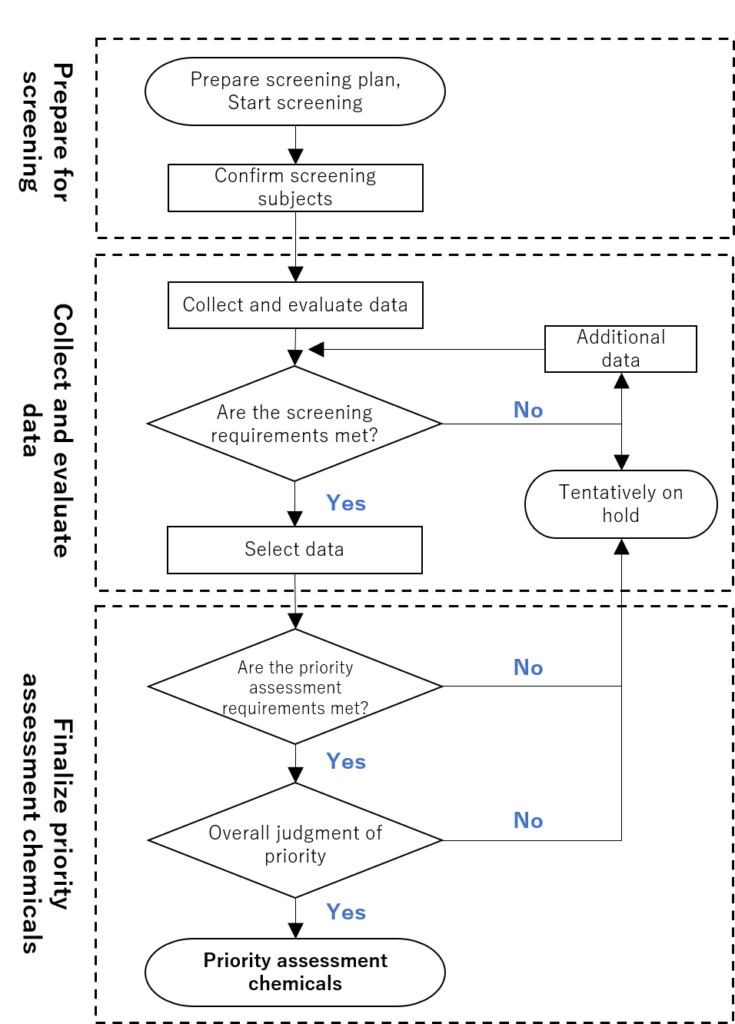On December 22, 2021, China’s Ministry of Ecology and Environment released the “Guidelines for Screening of Priority Assessment Chemical Substances” (HJ1229-2021). The guidelines came into effect on January 1, 2022. A draft of the guidelines for comments was published on April 29, 2021, and the official version was announced after adjusting the content based on the submitted comments.
A number of changes have been made to the document compared to the draft for comments. First, the definition of priority assessment chemicals has been adjusted as follows.
| Draft for comments | Official version |
|---|---|
The following conditions must be satisfied simultaneously:
|
The following conditions must be satisfied simultaneously:
|
The following substances must undergo a screening assessment as screening substances and the results of the assessment must be documented in a report.
- If the substance is a persistent, bioaccumulative and toxic substance (PBT), or very persistent and very bioaccumulative substances (vPvB), based on the Decision method of persistent, bioaccumulative and toxic substances, and very persistent and very bioaccumulative substances (GB/T 24782-2009).
- If the substance belongs to carcinogenicity, mutagenicity, or reproductive toxicity (CMR) category 1A or 1B based on the Rules for classification and labelling of chemical — Part 23: Carcinogenicity (GB 30000.23-2013), Rules for classification and labelling of chemicals — Part 22: Germ cell mutagenicity (GB 30000.22-2013), and Rules for classification and labelling of chemicals — Part 24: Reproductive toxicity (GB 30000.24-2013).
- If the substance is persistent and toxic, or bioaccumulative and toxic (for bioaccumulative substances, the requirements of “GB/T 24782-2009” must be met. In the case of a toxic substance, focus on whether it meets carcinogenicity, mutagenicity, reproductive toxicity, specific target organ toxicity (repeated exposure) or hazardous to the aquatic environment (long-term) category 2 or more based on “GB 30000.23-2013,” “GB 30000.22-2013,” “GB 30000.24-2013,” “Rules for classification and labelling of chemical — Part 26: Specific target organ toxicity — Repeated exposure (GB 30000.26-2013),” “Rules for classification and labelling of chemical — Part 28: Hazardous to the aquatic environment (GB 30000.28-2013)”)
- Other substances with high risk of harm (e.g., endocrine disruptors, substances suspected of being PBT/vPvB substances, substances suspected of being carcinogenic, mutagenic, or reproductive toxicity, substances classified as hazardous to the aquatic environment (long term) or specific target organ toxicity (repeated exposure) category 1, etc.)
The screening assessment procedure is as follows:

About the “Priority Regulated Chemicals List”
In the list published in stages by the Ministry of Ecology and Environment (which has been announced twice so far and contains a total of 40 chemicals), the chemicals included in the list are added to the relevant environmental management list and are subject to various environmental risk control measures. For example, if a substance is added to the list of “toxic and harmful air pollutants,” companies that emit the substance must comply with the relevant requirements under the “Air Pollution Control Act.” In addition, companies that use or release listed substances are subject to mandatory cleaner production screening. Listed substances are also incorporated into relevant national standards, etc., and their use is restricted or companies are instructed to switch to alternatives.
The original text of the “Guidelines for Screening of Priority Assessment Chemical Substances” can be viewed at the following URL (in Simplified Chinese):
https://www.mee.gov.cn/xxgk2018/xxgk/xxgk01/202112/t20211223_965035.html
 China’s Ministry of Ecology and Environment released the “Guidelines for Screening of Priority Assessment Chemical Substances”
China’s Ministry of Ecology and Environment released the “Guidelines for Screening of Priority Assessment Chemical Substances” 
























